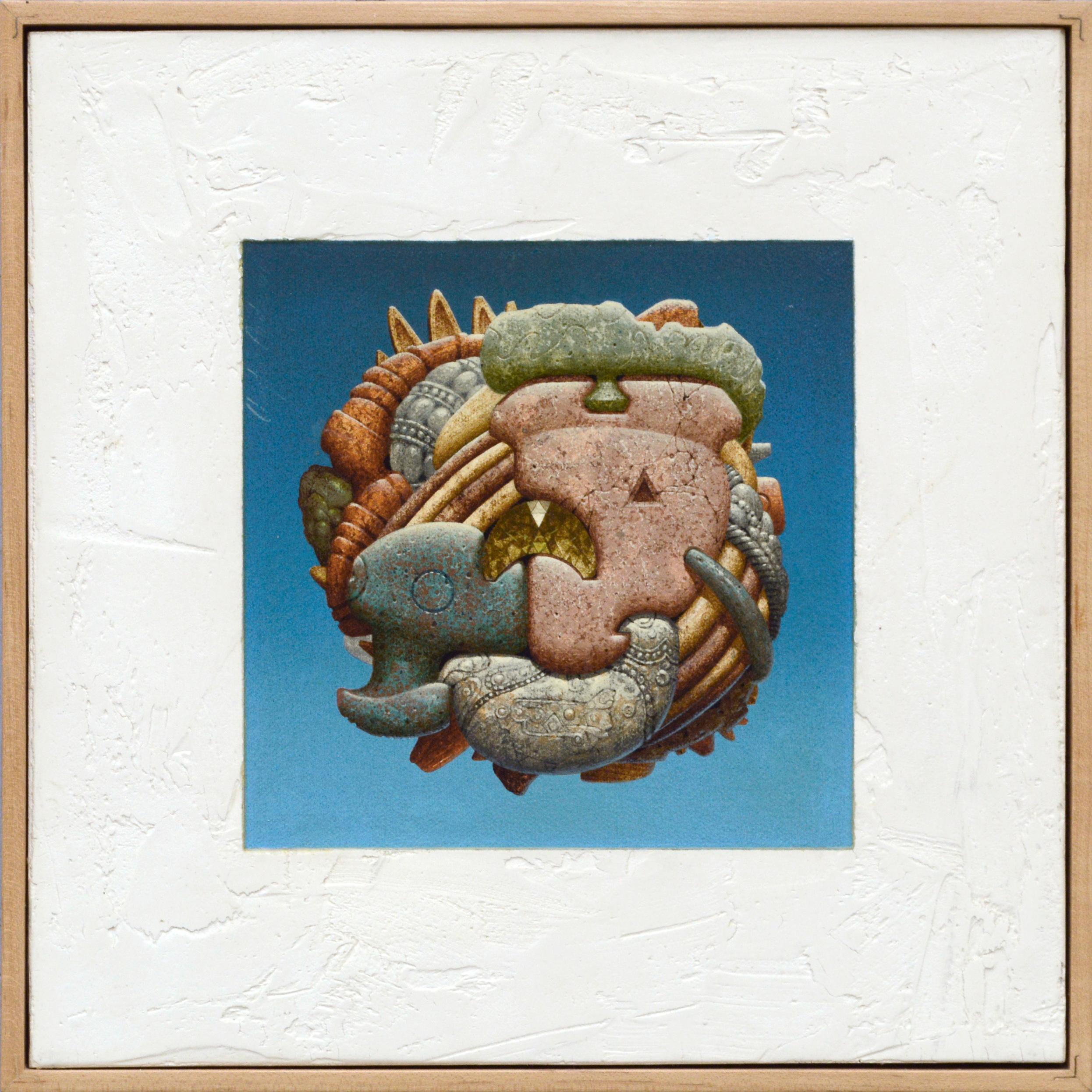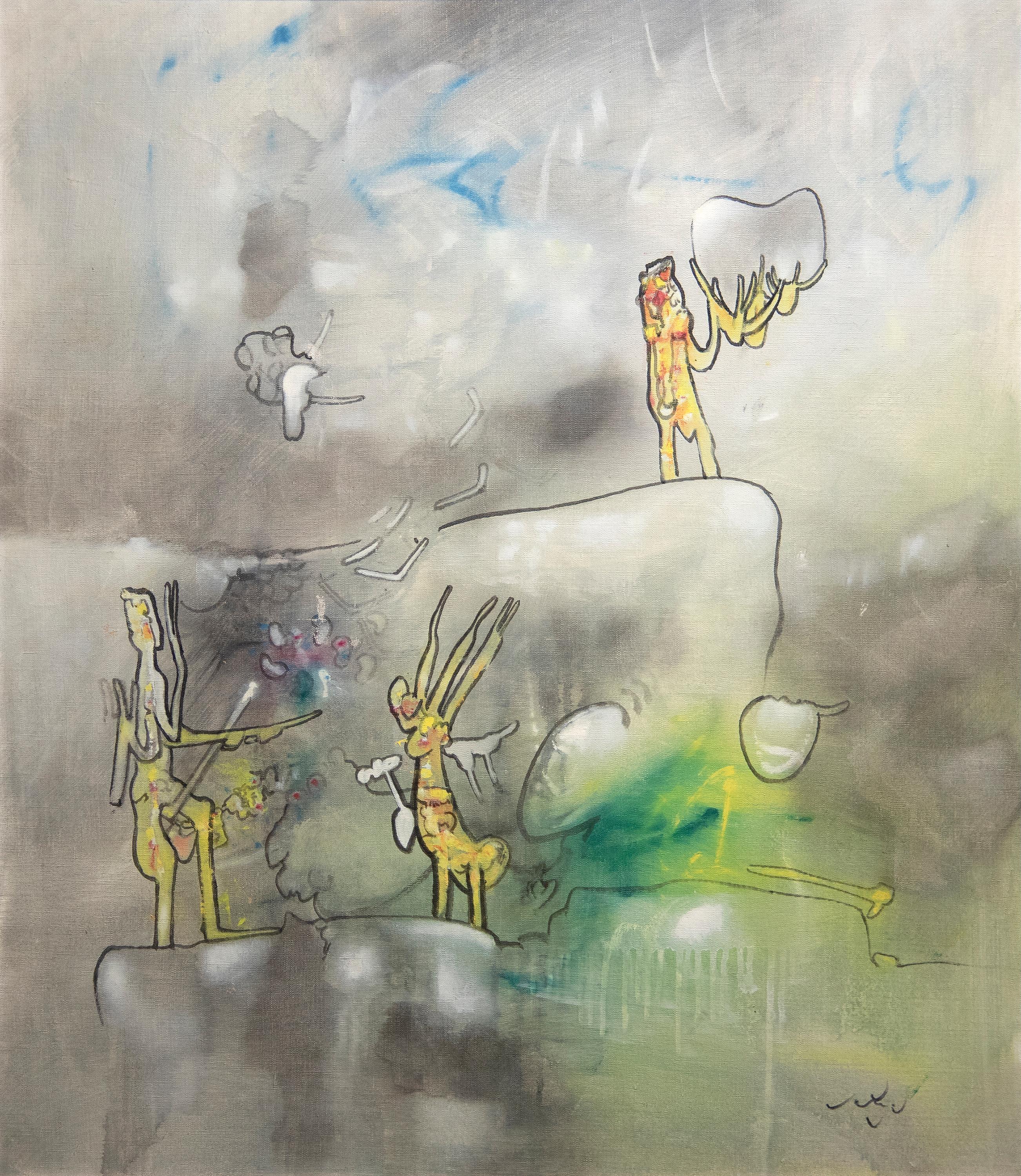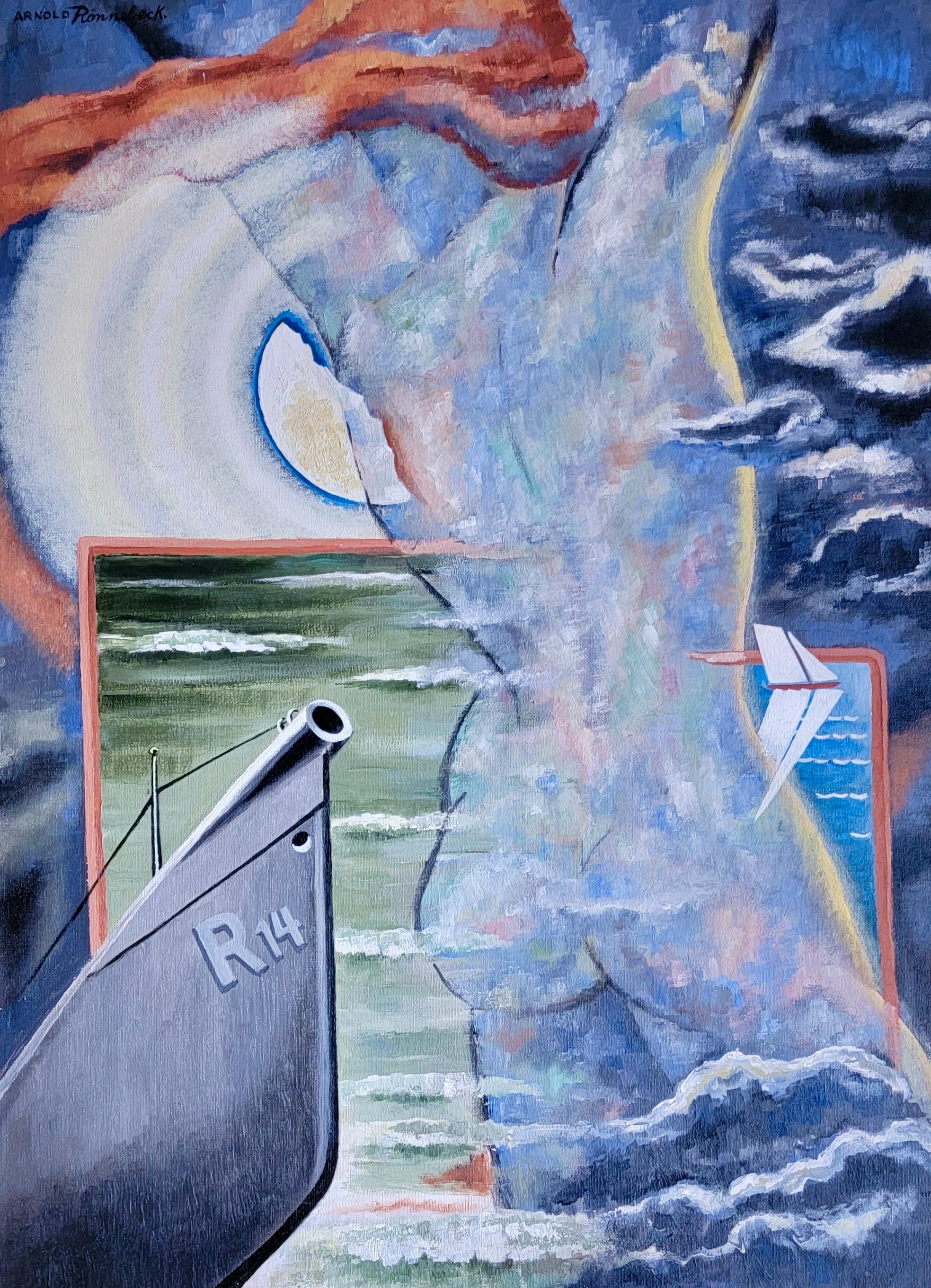Items Similar to Pavanne - 17th Century Court Dance - British exhibited Surrealist oil painting
Want more images or videos?
Request additional images or videos from the seller
1 of 14
John ArmstrongPavanne - 17th Century Court Dance - British exhibited Surrealist oil painting 1944
1944
About the Item
Painted by "Modern British" Surrealist artist John Armstrong this oil/tempera on board depicts Pavanne. The Pavanne is a 17th century Court dance. The figures bunch up rhythmically and are almost camouflaged in the darkness, almost invisible. Quite what the significance in 1944 of this historical subject is, we are not sure, but the dark overtones in the shadowy large figures with golden head and glowing hands make it quite a mystical work. It is an almost Surreal Modern British artwork and a very interesting painting. The work is painted by a very rare to find artist who is highly sought after. The painting was dirty when purchased. However since cleaning the 80 years of dirt away it has revealed the stunning figure group with their heads and golden hands and the signature and date in the lower right. A real gem of a painting has been revealed with the restoration clean. It is an important early British Surrealist work and has excellent provenance.
Signed and dated 1944 lower right.
Provenance. Alex Reid / Lefevre Galler 1945.
Condition. oil/tempera on board, 34 inches by 20 inches unframed and in good condition.
Housed in its original fine gallery frame, 43 inches by 29 inches framed and in good condition.
John Rutherford Armstrong ARA (1893-1973) was a British artist and muralist who also designed for film and theatre productions. He is most notable for the Surrealist paintings he produced. Armstrong was born in Hastings in Sussex. His father was a clergyman and Armstrong was educated at St. Paul's School in London. He studied law at St. John's College, Oxford, but switched to art and became a student at St John's Wood Art School throughout 1913 and 1914. Armstrong served with some distinction in the Royal Field Artillery in Salonika during World War One before returning briefly to complete his studies at St John's Wood Art School. After a period of some economic hardship, Armstrong began to build a career as a theatre designer in London and to gain a client base for his artworks. He received a commission to decorate a room in the Portman Square home of the art collector Samuel Courtauld, and also painted a frieze for the ballroom at 1 Kensington Palace Gardens. Armstrong held his first solo exhibition in 1928 at the Leicester Galleries in London. In 1933 he joined Unit One and displayed a set of semi-abstract paintings at their one, extended, exhibition. Throughout the 1930s Armstrong continued to work as a designer as he also continued to develop his art. He produced a number of remarkable posters for Shell and also produced four posters for the General Post Office. Armstrong designed a number of book covers for the Hogarth Press, including for William Plomer's Sado published in 1931. He worked on the first production of the ballet Façade and on a number of Alexander Korda's film productions, designing costumes for The Private Life of Henry VIII, Rembrandt and I Claudius. In 1938 Armstrong held an exhibition at the Lefevre Gallery which featured Surrealist works set in English landscapes such as Dreaming Head. Pro Patria, also from 1938, is Armstrong's comment on the Spanish Civil War. During World War Two, Armstrong worked as an official war artist undertaking short contracts for the War Artists' Advisory Committee, WAAC. In paintings such as The Elms and A Farm in Wales he recorded bomb damage to buildings such as churches and cottages. Whilst other artists, including John Piper, praised these works they were criticized by the art critic Eric Newtown in the Sunday Times as being superficial. Several works by Armstrong were included in the WAAC Britain at War exhibition held at the Museum of Modern Art in New York in May 1941. After the War, Armstrong turned away from surrealism and towards the greater use of symbols in his paintings. He produced a series of large symbolic works including The Storm for the Festival of Britain, The Battle of Propaganda, The Battle of Money and Victory, the last of which imagined the results of a nuclear attack. The painting was shown at the Royal Academy in 1958 and attracted considerable public attention. In 1955 he designed and painted the ceiling of the Council Chamber for the City Hall, Bristol and also created a light-hearted mural, The Fantastic Park, for the Royal Marsden Hospital in Surrey. Armstrong was elected an associate member of the Royal Academy in 1966 and, despite developing Parkinson's disease, he continued to paint and travel until his death in London in 1973. A memorial exhibition for Armstrong was held at the Royal Academy in 1975
- Creator:John Armstrong (1856, British)
- Creation Year:1944
- Dimensions:Height: 43 in (109.22 cm)Width: 29 in (73.66 cm)Depth: 2 in (5.08 cm)
- Medium:
- Movement & Style:
- Period:
- Condition:
- Gallery Location:London, GB
- Reference Number:1stDibs: LU853113046702
About the Seller
5.0
Platinum Seller
These expertly vetted sellers are 1stDibs' most experienced sellers and are rated highest by our customers.
1stDibs seller since 2018
400 sales on 1stDibs
Typical response time: <1 hour
- ShippingRetrieving quote...Ships From: London, United Kingdom
- Return PolicyA return for this item may be initiated within 14 days of delivery.
More From This SellerView All
- Red Idol - British 50's art abstract oil painting - Modernist COBRA - provenanceBy William GearLocated in London, GBAn original oil on canvas by the noted Scottish artist William Gear. A fabulous painting. One of his best and a seminal work which dates to 1959. Provenance. Douglas Foulis Art Galle...Category
1950s Abstract Abstract Paintings
MaterialsOil
- Death of the Young Men 1938 - British art figurative Surrealist oil paintingBy Jack SassoonLocated in London, GBAn oil on canvas painted by Jack Sassoon which was certainly a premonition of what was to come. Entitled Death of the Young Men and dated 1938, it depicts men in gas masks and a woma...Category
1930s Surrealist Figurative Paintings
MaterialsOil
- Christ Expelling Money Changers - British 30's surrealist art religious interiorBy Augustus LunnLocated in London, GBPainted by "Modern British" artist Augustus Lunn this oil/tempera on board depicts Christ Expelling the Money Changers. He exhibited widely at The Cooling Galleries and The New Engl...Category
20th Century Surrealist Figurative Paintings
MaterialsOil
- Myth III - British 1936 Modern art tempera painting Ida Graves poet familyBy Blair Hughes-StantonLocated in London, GBThis superb British 1930's modern art tempera painting is by noted interwar artist Blair Hughes-Stanton. Painted in 1936 it is part of the myth se...Category
1930s Modern Figurative Paintings
MaterialsEgg Tempera
- Travelling Comic Theatre - Italian 18thC art figurative landscape oil paintingBy Marco MarcolaLocated in London, GBThis interesting Italian 18th century Old Master oil painting is by noted artist Marco Marcola, also known as Marco Marcuola. It was painted circa 1770 and has excellent provenance. ...Category
1770s Old Masters Figurative Paintings
MaterialsOil
- The Entombment - British art 30's oil painting religious landscape Jesus angelsLocated in London, GBA huge British adaptation of The Entombment. Oil/Tempera on panel by E G Tucker. The scene depicts Jesus being wrapped whilst the angels look on. The work was executed for The Roma...Category
1930s Realist Figurative Paintings
MaterialsOil
You May Also Like
- Colorful Surreal Abstract Expressionist Painting of a Macabre Group of ClownsLocated in Houston, TXSurreal abstract expressionist painting of a group of clowns in the style of Belgian painter James Ensor. Combining the macabre with the playful, the work features distorted clowns a...Category
1990s Surrealist Figurative Paintings
MaterialsTempera
- In the garden. 1970s Cardboard, tempera, 59x59 cmBy Vladimir GlushenkovLocated in Riga, LVIn the garden. 1970s Cardboard, tempera, 59x59 cm Vladimir Borisovich Glushenkov (May 21, 1948, Riga - December 26, 2009, Riga.) - painter, graphic artist, poet, translator. Born i...Category
1970s Surrealist Figurative Paintings
MaterialsMixed Media, Tempera, Cardboard
- Vintage Surrealist Composition - Precious Stones AbstractBy Clayton AndersonLocated in Soquel, CAHighly detailed surrealist composition evoking tribal, abstracted carved stone-like shapes fitting together like a three dimensional sphere shaped puzzle, floating in a sky blue space by Clayton Anderson (American b. 1943). Textured plaster border around the edge of the piece. Signed "Clayton Anderson" along the upper left edge and on verso. Presented in a deep maple box frame. Clayton Anderson (American, b. 1943) studied at the Pennsylvania Academy of the Fine Arts and worked with Ben Kimihira, Walter...Category
1970s Surrealist Abstract Paintings
MaterialsPlaster, Oil, Wood Panel
- L'epreuveBy Roberto MattaLocated in Palm Desert, CAA painting by Roberto Matta. "L'epreuve" is a surrealist painting, oil on canvas in palette of grays, greens, and yellows by Latin American artist Roberto Matta. It is signed in the ...Category
Mid-20th Century Surrealist Abstract Paintings
MaterialsCanvas, Oil
- Surrealist orixa Brazil acrylic on board painting surrealism UbedaLocated in Barcelona, BarcelonaGustavo Úbeda (1930-1994) - Orixa - Acrylic on panel Acrylic measurements 61x91 cm. Frameless. The painting by Gustavo Úbeda Romero (Herencia, 1930 – Sao Paulo, 1994) comes from a f...Category
1970s Surrealist Figurative Paintings
MaterialsAcrylic, Board
- "Two Seas and a Moon" Surrealism American Scene WWII Modern WWI Denver WPA EraBy Arnold RönnebeckLocated in New York, NY"Two Seas and a Moon" Surrealism American Scene WWII Modern WWI Denver WPA Era Arnold Ronnebeck (1885 - 1947) Two Seas and a Moon 30 x 22 1/2 inches Oil on Canvas, c. 1943 Signed u...Category
1940s Surrealist Figurative Paintings
MaterialsCanvas, Oil



